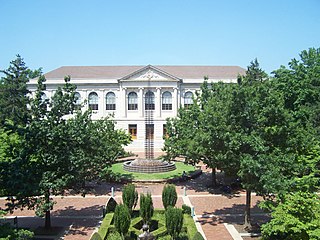Related Research Articles
The Master of Architecture is a professional degree in architecture qualifying the graduate to move through the various stages of professional accreditation that result in receiving a license.

The College of Architecture, Art, and Planning (AAP) at Cornell University is one of the world's most highly regarded and prestigious schools of architecture and has the only department in the Ivy League that offers the Bachelor of Architecture degree. According to DesignIntelligence, Cornell architecture students are the most desired recent graduates by architecture firms, especially in New York City. The department has one of the largest endowments of any architecture program, including a $20 million endowment by Cayuga County resident Ruth Price Thomas in 2002. The Master of Regional Planning (M.R.P.) professional degree program at AAP has been consistently ranked in the top 10 in the nation, according to Planetizen's Guide to Graduate Urban Planning Programs.
Texas A&M School of Architecture is a school of Texas A&M University at College Station.
A terminal degree is the highest-level college degree that can be achieved and awarded in an academic discipline or professional field. In other cases, it is a degree that is awarded because a doctoral-level degree is not available nor appropriate.
A Bachelor of Architecture (BArch) is a bachelor's degree designed to satisfy the academic requirement of practising architecture around the world.
Doctor of Architecture is a title accorded to students who have completed a degree program accredited by the National Architectural Accrediting Board. The only university currently offering a Doctor of Architecture degree is the University of Hawaii at Manoa.

NewSchool of Architecture & Design is a private for-profit college in San Diego that focuses on architecture and design. It is accredited by the WASC Senior College and University Commission (WSCUC).

Texas Tech University College of Architecture is the college of architecture at Texas Tech University in Lubbock, Texas. The architecture program has existed at Texas Tech University since 1927. Texas Tech's Master of Architecture is a professional degree and it is accredited by the National Architectural Accrediting Board (NAAB). On November 30, 2022, the school announced it would be named the Huckabee College of Architecture.

The University of Illinois School of Architecture is an academic unit within the College of Fine & Applied Arts at the University of Illinois Urbana-Champaign. The school is organized around four Program Areas - Building Performance, Detail + Fabrication, Health + Well-being, and Urbanism. Faculty teach and conduct research in these areas in support of the School's primary objective to promote critical engagement with the design of a healthy and sustainable built environment.

The California Polytechnic State University College of Architecture and Environmental Design is one of Cal Poly San Luis Obispo's six colleges. Cal Poly's CAED program has nearly 1,900 students and is one of the largest programs in the United States. The college offers bachelor's degrees in five departments, as well as two master's degree programs.

The University of Utah College of Architecture + Planning is an academic college of the University of Utah, offering undergraduate and graduate degrees in architecture, city and metropolitan planning and multi-disciplinary design. The College also offers graduate certificates in historic preservation, urban planning, real estate development and urban design. The College is the only accredited architecture program in the state of Utah.

The Fay Jones School of Architecture and Design, founded in 1946 by John G. Williams at the University of Arkansas, offers education in these fields: architecture, landscape architecture and interior design.
The Cal Poly Pomona College of Environmental Design (CENV) is a college part of the California State Polytechnic University, Pomona. The college houses over 1,600 students; making it one of largest environmental design programs in the United States. The college offers bachelor's degrees in five departments, as well as three master's degree programs. It offers a Master of Interior Architecture, professional degree in collaboration with the University of California, Los Angeles (UCLA).

The California State Polytechnic University, Pomona is organized into seven academic colleges, one extension college, and one professional school. These units provide 65 majors, 20 master's degree programs and 13 teaching credentials/certificates.
The USC School of Architecture is the architecture school at the University of Southern California. Located in Los Angeles, California, it is one of the university's twenty-two professional schools, offering both undergraduate and graduate degrees in the fields of architecture, building science, landscape architecture and heritage conservation.
Professional requirements for architects vary from place to place, but usually consist of three elements: a university degree or advanced education, a period of internship or training in an office, and examination for registration with a jurisdiction.

The College of Architecture, Arts, and Design formerly the College of Architecture and Urban Studies at Virginia Tech consists of four schools, including the School of Architecture, which consistently ranks among the best in the country. Headquartered in Blacksburg, Virginia, the college also has sites in Alexandria, Virginia, and Riva San Vitale, Switzerland. Spread out among these three locations, the college consists of nearly 2,200 students, making it one of the largest schools of architecture in the nation.

Auburn University's College of Architecture, Design and Construction (CADC) is one of fourteen colleges and schools that comprise Auburn University, a land, sea and space grant institution located in Auburn, Alabama. The CADC offers undergraduate programs in architecture, interior architecture, landscape architecture, building construction, environmental design, graphic design, and industrial design. The College also offers graduate programs in building construction, landscape architecture, industrial design, executive real estate development, and distance education in construction management.
References
- ↑ http://www.archcareers.org/website/article.asp?id=13 Archived 2013-01-01 at the Wayback Machine "Arch Careers.org. Architecture Degree Programs", Retrieved on April 4th, 2013.
- ↑ http://www.ncarb.org/Studying-Architecture/Difference-Between-NAAB-Accredited-And-Non.aspx "DIFFERENCE BETWEEN NAAB-ACCREDITED AND NON-ACCREDITED PROGRAMS", NCARB, Retrieved on April 4th, 2013.
- ↑ Beatty, MaryAnne. http://www.gsa.gov/portal/content/197325 "GSA Moves to LEED Gold for All New Federal Buildings and Major Renovations", the General Services Administration , Retrieved on April 4th, 2013.